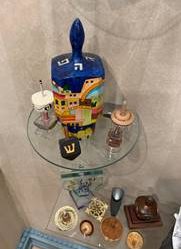 I collect dreidels. Lots of them. From the United States, from Israel, from Spain, Hungary, India, Russia, Scotland… from all over the world! Dreidels made from glass, from wood, from metal and, yes, from clay. Ornate dreidels and simple ones. Dreidels that make noise, dreidels that make light, dreidels that make music.
I collect dreidels. Lots of them. From the United States, from Israel, from Spain, Hungary, India, Russia, Scotland… from all over the world! Dreidels made from glass, from wood, from metal and, yes, from clay. Ornate dreidels and simple ones. Dreidels that make noise, dreidels that make light, dreidels that make music.
I began my collection nineteen years ago when I met my beloved wife, Clary. That meeting took place on the second night of Chanukah and the dreidel came to symbolize that wonderful meeting. But, it seems fair to ask, wouldn’t a single dreidel, even a magnificent one, have been sufficient to commemorate that life-transforming moment? Why amass dreidel after dreidel, growing my collection into one of the most impressive dreidel collections.
 It would be easy to dismiss my collection as romanticism or mere whimsy, a remembrance of meeting Clary or a chance to recall the delightful, innocent Chanukah evenings of my childhood but to do so would miss something powerful in the message of those little tops and it seems to me that the dreidel represents much more than either of those things.
It would be easy to dismiss my collection as romanticism or mere whimsy, a remembrance of meeting Clary or a chance to recall the delightful, innocent Chanukah evenings of my childhood but to do so would miss something powerful in the message of those little tops and it seems to me that the dreidel represents much more than either of those things.
Consider, what does the dreidel teach us? Nes Gadol Haya Poh (in Israel) or Nes Gadol Haya Sham (outside Israel). A great miracle happened t/here!
One need only step into my library and be witness to the countless reminders that miracles surround us, here, there, and everywhere. No matter where we look, our lives are touched by miracle. Our lives are miracles.
The question should not be, Why so many dreidels? Rather, it should be, Why not more and more and more?
Just as God is everywhere, so too are the miracles that He brings about. His miracles are as unceasing as His love. Each day, when we recite, Modim anachnu lach… we are reminded of God as the source of all daily miracles. Ve’al nisecha she’b’chol yom imanu (“and for Your miracles (nissim) that are with us every day; and for Your wonders and favors (niflaos) in every season.”
We can never exhaust our praise for God’s wonders and miracles.
 Like miracles, wonders (niflaos) surround us everywhere. They are, at once, special and ordinary. So ordinary that we often take them for granted. The rain, the blossoming flower, the brilliance of a blue sky, even the very air we breathe. All these wonders… yet we experience them without giving them a second thought! We call them teva, nature. And we experience them the way we do because they represent the wonderful world the way it is supposed to be.
Like miracles, wonders (niflaos) surround us everywhere. They are, at once, special and ordinary. So ordinary that we often take them for granted. The rain, the blossoming flower, the brilliance of a blue sky, even the very air we breathe. All these wonders… yet we experience them without giving them a second thought! We call them teva, nature. And we experience them the way we do because they represent the wonderful world the way it is supposed to be.
And yet, we don’t think of miracles as being ever-present. Miracles are… well, miraculous. We recognize miracles as being “out of the ordinary.” We consider a miracle to be, quite literally, “nothing short of miraculous.”
Which brings us back to Chanukah. During the time of the Second Temple, a small, valiant band of Jews fought the mighty Greek armies. They miraculously defeated them and won back not only the Temple but their religious freedom. This was a miracle no one could miss.
Yet, our Sages teach that there is no real difference between nature and miracles; God’s hand guides everything in the world. However, we are often so lost in our routine that we become blind to the wonder of God’s hand all around us. “Nature” is just the word we use to speak of the breathtaking beauty and symmetry of God’s Creation becoming routine.
We are familiar with it. We expect it.
 A miracle, though, shakes us from our stupors. A miracle breaks our routine and draws our attention to God’s dominion over all life.
A miracle, though, shakes us from our stupors. A miracle breaks our routine and draws our attention to God’s dominion over all life.
Dreidels, delightful, wonderful, playful little dreidels, remind us of the existence of miracles.
During the Second Temple era, a small band of Jews battled valiantly against the Greek armies and miraculously overcame them thus restoring their religious practice and sovereignty. On 25 Kislev, Jews went to resume lighting the Temple’s Menorah but found that all the oil had been contaminated by the Greeks save for one sealed flask containing only enough oil to burn for one night. Yet the oil burned for eight days and, so the eight days of Chanukah.
Beit Yosef asks, “Why do we celebrate Chanukah for eight days if there was ample oil to last for one day? The miracle was that the oil lasted an additional seven days… in which case, Chanukah should be celebrated for seven days, not eight.”
“Chanukah” is a contraction of chanu kaf-heh, i.e., they camped [rested from war] on the 25th of Kislev. Odd that the holiday’s name would recall the lull in the fighting rather than the victory.
Perhaps it is to suggest that we seek (and find) miracles in the everyday rather than the extraordinary. As we’ve said, God’s hand is everywhere. Perhaps the miracle is the event that wakes us up to notice. It was only in the calm before the final victory that we could recognize God’s intervention.
Chanukah teaches us that we should never take anything for granted, miracles abound. We need only stop our headlong rush forward to note them. We are just like the dreidels, spinning, spinning, always spinning. And, as the dreidel spins, it is a blur, its letters unrecognizable. It is only when the dreidel stops that we can see the message clearly, nes gadol haya poh, nes gadol haya poh/sham.
The Levush comments on the phrase used in the opening sentence of Al ha’Nisim, recited throughout Chanukah, when we praise God, “for the miracles, and for the salvation…. which You performed for our forefathers – bayamim ha’em bazman ha’zeh – in those days, at this time.”
Which is it? In those days, or at this time? Levush tells us the phrase refers to a “double dose” of praise – for the miracles of yesteryear and for the countless miracles we experience each and every day. Every breath, every sunset and sunrise, every newborn, is a new miracle bazman hazeh.
 Which brings us back to Beis Yosef’s question. With only a single day’s supply of oil, the lights lasted eight. Why eight days rather than the “miraculous” seven additional days? Why include the first day, which was expected? The Ramban suggests it is because teva, that which we recognize as the everyday as natural and normal, is also a miracle. The Chazon Ish agrees, teaching that teva are merely miracles that recur on a steady and regular basis. That oil can burn and give us light is, in and of itself, a miracle!
Which brings us back to Beis Yosef’s question. With only a single day’s supply of oil, the lights lasted eight. Why eight days rather than the “miraculous” seven additional days? Why include the first day, which was expected? The Ramban suggests it is because teva, that which we recognize as the everyday as natural and normal, is also a miracle. The Chazon Ish agrees, teaching that teva are merely miracles that recur on a steady and regular basis. That oil can burn and give us light is, in and of itself, a miracle!
Rav Chanina ben Dosa forewarned his daughter (Taanis 25a), “The One Who commanded oil to burn, He can command vinegar to burn as well.” We need to be reminded of the great Chanukah miracle, that a mere one day’s supply of oil burned for eight. We also need to remember what we too often forget – that for oil to burn at all is a miracle too.
Ramban teaches that it is through a recognition of the great miracles that one can ultimately recognize and praise the “small” miracles, the miracles hidden in plain sight. By the same token, until we recognize and embrace life’s “mundane” miracles, we are sure to remain blind to the great miracles that cannot help but astound us.
Rav Yeruchem Levovitz teaches, “What is a miracle? It is a window into God’s conduct of the world.”
A miracle allows us to witness with open eyes God’s influence on the natural order. As we gaze upon those on-going, wondrous alterations how can we fail to acknowledge that the very same God Who performs such great miracles is the very God Who maintains the world; Who spins it and all that is in it. The everyday – teva – is a wonder! A miracle!
Each dreidel reminds me of that truth.
How could I ever have too many?

